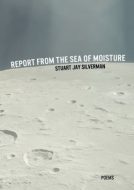 Report From the Sea of Moisture
Report From the Sea of Moisture
Stuart Jay Silverman
Atmosphere Press
Reviewer: Shawn Pavey
Report From the Sea of Moisture is my first exposure to the poetry of Stuart Jay Silverman, but it will not be my last. The absence of either blurbs or an author bio and photo on the back cover in favor of what amounts to an artist’s statement struck me as odd, self-aware, and even a bit smug. I was wrong. After reading this crafted, complex, and expertly curated collection several times, I realized that Silverman’s statement about his approach to poetry serves as a necessary guidepost that, combined with the index in the book’s final pages, provides a legend to help the reader navigate a dense and lush landscape.
This is not Instagram poetry. It is not “woke,” although it is sensitive and thoughtful. This is capital letter “P” Poetry that we see so rarely now, rich in allusions to classical mythology, literature, and art. This book would claim Ezra Pound and William Carlos Williams as ancestors much more than most poetry published in the contemporary market. But in its deep nod to the classical canon, it emerges, now, fresh and uncompromising.
Abandonment of the confessional poem is welcome here in in the late stages of the Pandemic. Penned in an elevated language, Silverman’s work shares more with Schwartz and Wilbur than it does Whitman or Ginsberg. While I consider myself, if not well-read, at least adequately-read, Silverman uses language I needed to investigate, classical references I needed to explore for greater context. Keeping a good dictionary handy and a device to access Wikipedia will serve the reader well. It comes as no surprise, per Silverman’s bio, that he is a recently retired professor.
Silverman makes the reader work for understanding. On the surface, each of these poems is beautiful, the lexicon is musical, the sense of cadence and pacing is masterful. To hear this work read aloud would be its own treat, but it takes work to get at the heart of these poems and that work provides its own reward. These poems teach us how to read poetry again.
Take the poem “A Battle at Sea,” in which the poet reaches through time to tell a story when only images remain, painted on a Greek krator, a ceramic urn, in which fresh spring water diluted wine.
What did he think, the sailor-warrior
camped aloft brandishing a spear
while the pirate-Greeks came on,
prow splitting the calm Tyrhene?
Was it the purple wine, thinned to a sun-lit puce
by water from a hidden spring,
that he drank in the cool shade of an arbutus
on the flagstones ringing the temple walls?
Did he fear the fall to the plank deck
or a two-edged spear point
embedded in the breastbone, the lucky pitch
of a helmed Greek a ships-breadth away?
He sways in the mind across the centuries,
a stick-man almost lost above the battle
ended one way or the other in the fabulous ago.
Neither the scholars parsing his kind with a patient care,
nor the poets building a world in which he might exist once more,
can find a way to the heart of this mystery.
A hunter, doomed by a glimpse, no more,
but more than the gods sanctioned, then or now,
of what time and fate hide from human eyes,
left his blood on the Thessalian plains.
Torn by the hounds who saw only the stag,
he has become the myth of afterwards.
All that remains of the Etruscan sailor
is perched on the clay of the Aristonthonos Crater.
Not even the Etruscan smile
humanizes the challenge of this earth.
Silverman paints with language the image about which he writes, tells the story as it is shown on the clay vessel, creates a story that imagines the sailor’s life, and then muses about how the true story may never be known. All we have is what is in front of us, the rest is speculation as to what truly occurred in “the fabulous ago.” In four stanzas, the poet shows us the image and imagines a person drinking from this very vessel, then brings us back to the now and our awareness that we will never know the true story or the actual lives of the people this artifact touched throughout its history.
Silverman’s broad palette and intuitive sense of music take the reader from the first word to the last in a complicated and twisting journey. There are great surprises here. As in several other poems in this collection, we see the poet’s embrace of the long line and subtle poetics that carry the cadence from line to line, consonants and vowels echoing throughout.
In “A Bloomsbury Portrait,” Silverman gives us a vivid snapshot of a character:
“He was always the last to leave,
after the bottom of the punch bowl
had given up its final honeyed sip.
He half-leaned against the bolster
for a time. If he spoke further,
his voice crept by in a whisper,
as though aware that an emptiness
had sunk in on which words intrude.
Then, if he spoke, he would look
toward the grape-and-dart molding
High up the wall where words might,
perhaps, escape attention and be
dissipated to the night, but some
stayed to haunt the morning light.”
The character speaks little, drinks deeply, tries not to be seen, and, when speaking, looks for words that may otherwise “be dissipated to the night.”
There are many poems of varying lengths in this collection through which Silverman further explores the use of long lines, rhythmic cadences, delicate applications of assonance and consonance, internal and slant rhyme … elements that one’s professor might point out from the great works of past masters.
Spend time with this book. Reading it in a single sitting does it no justice. Let these poems ramble about as they travel from room to room. Read it outside on a bright and temperate day.

